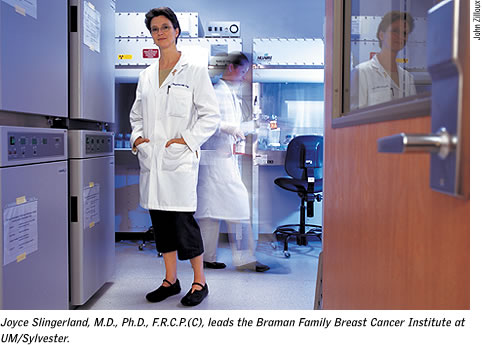
Researchers at the University of Miami Sylvester
Comprehensive Cancer Center have identified how an important
growth control mechanism is disabled in cancers—and have
successfully restored its function in the lab. The research
promises to eventually help restore the effectiveness of some
breast cancer drugs in cancers that have become drug-resistant.
Joyce M. Slingerland, M.D., Ph.D., F.R.C.P.(C),
director of the Braman Family Breast Cancer Institute at
UM/Sylvester,
identified how a key growth inhibitor protein is switched off,
allowing cancer to proliferate and spread. “Our work
solves a big puzzle in this field that has been around for
almost ten years,” says Slingerland.
A growth inhibitor, p27, normally holds
the kinase, cyclin E-Cdk2, in check to prevent cells from
starting a new round
of DNA synthesis that would lead to cell division. Thus,
p27 essentially keeps the brakes on cell division. Slingerland’s
group has shown that Src, an oncogene first identified more
than 30 years ago, can inactivate p27, leading to its destruction,
and switch on cyclin E-Cdk2. A majority of human cancers, including
ovarian, prostate, colon, lung, and breast, have reduced levels
of the p27 growth inhibitor protein. The mystery was how a
kinase specifically constrained by p27 could suddenly turn
the tables and destroy its own inhibitor. “The conundrum
was solved by our recent findings that, early on after growth
factors and estrogen give the cell the ‘go’ signal
to divide, Src is turned on, and Src then binds to p27 and
causes the inhibitor to lose its inhibitory function,” Slingerland
says.
The gene Src is switched on by several
factors, including two that are important in breast cancers—human epidermal
growth factor receptor 2 (HER2) and estrogen. This latest work
by the Braman Family Breast Cancer Institute provides new insights
into how estrogen and HER2 contribute to breast cancer growth.
Estrogen and HER2 are known to activate Src. Slingerland’s
work now links Src to loss of the p27 growth inhibitor, or
loss of the “brakes” on cell division. “This
work provides a brand-new understanding of the mechanism whereby
Src activates cancer cells to grow and divide,” says
Slingerland, a professor of medicine at the UM Miller School
of Medicine.
Slingerland and her colleagues looked
at tamoxifen-resistant breast cancer cell lines in the lab.
They found that four
out of six of these cell lines had high levels of Src and low
levels
of p27. They decided to combine tamoxifen with an experimental
drug to inhibit Src that is being developed by a pharmaceutical
company. “When we combined this Src inhibitor with tamoxifen,
we found that the resistant cells that had particularly high
levels of Src were completely corrected and their sensitivity
to tamoxifen was restored,” she says.
“Then the question was whether we could show that this
relationship exists in human breast cancer tissues,” says
Slingerland. “So
we stained 482 human breast cancers for p27 and tested if
tumors that had low p27 might also be the ones with activated
Src.
We were gratified to find that indeed, in the human breast
tumors, low p27 was correlated with high Src activity.”
Almost a decade ago, Slingerland was among the first researchers
to recognize the relationship between reduced levels of p27
and poor outcomes for women with breast cancer. A variety
of tumors with reduced levels of p27, |
|